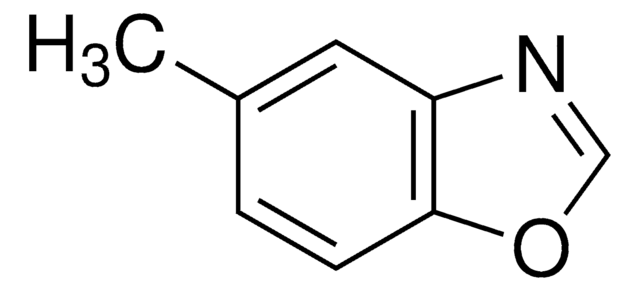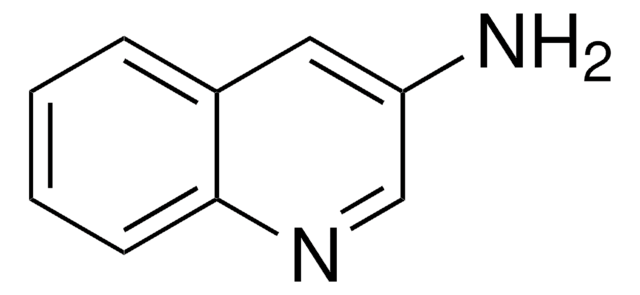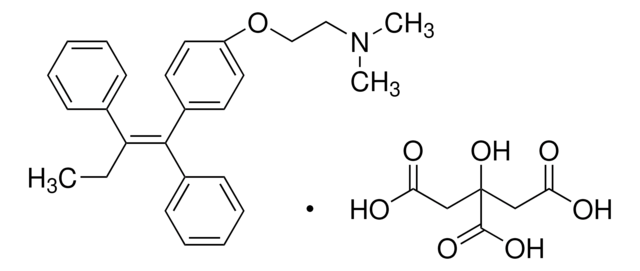T176
4-Hydroxytamoxifène
analytical standard, (E) and (Z) isomers (50:50)
Synonyme(s) :
4-(1-[4-(Diméthylaminoéthoxy)phényl]-2-phényl-1-butényl)phénol, 4-OHT, cis/trans-4-Hydroxytamoxifène
About This Item
Produits recommandés
Qualité
analytical standard
Niveau de qualité
Forme
powder
Technique(s)
HPLC: suitable
gas chromatography (GC): suitable
Solubilité
ethanol: 20 mg/mL
Spectre d'activité de l'antibiotique
neoplastics
Application(s)
forensics and toxicology
pharmaceutical (small molecule)
Format
neat
Mode d’action
enzyme | inhibits
Chaîne SMILES
CC\C(c1ccccc1)=C(/c2ccc(O)cc2)c3ccc(OCCN(C)C)cc3.CC\C(c4ccccc4)=C(\c5ccc(O)cc5)c6ccc(OCCN(C)C)cc6
InChI
1S/2C26H29NO2/c2*1-4-25(20-8-6-5-7-9-20)26(21-10-14-23(28)15-11-21)22-12-16-24(17-13-22)29-19-18-27(2)3/h2*5-17,28H,4,18-19H2,1-3H3/b26-25+;26-25-
Clé InChI
ZJLDABGSDWXVGE-BDSXMVAQSA-N
Informations sur le gène
human ... ESR1(2099) , ESR2(2100) , ESRRG(2104) , IL6(3569)
rat ... Ar(24208) , Esr1(24890) , Esr2(25149)
Vous recherchez des produits similaires ? Visite Guide de comparaison des produits
Description générale
Application
- Determination of tamoxifen and its three metabolites from dried blood spot (DBS) discs by ultra-high performance liquid chromatography-electrospray ionization-tandem mass spectrometry (UHPLC-ESI-MS/MS)
- Simultaneous estimation of tamoxifen, 4-hydroxytamoxifen, and endoxifen from DBS samples by UHPLC-MS/MS
- Development and validation of a non-aqueous capillary electrophoretic (NACE) method coupled with capacitively coupled contactless conductivity detection (C4D) to analyze tamoxifen and its three main metabolites after their liquid-liquid extraction (LLE) from human plasma samples obtained from breast cancer patients
- Multi-residue analysis of human plasma samples to quantify tamoxifen and its degradation products using the non-aqueous capillary electrophoretic (NACE) method combined with UV-detection
- Combined detection of tamoxifen and centchroman, along with their degradation products in human plasma samples by LC-ESI-MS/MS
Actions biochimiques/physiologiques
Autres remarques
Mention d'avertissement
Warning
Mentions de danger
Classification des risques
Acute Tox. 4 Dermal - Acute Tox. 4 Inhalation - Acute Tox. 4 Oral - Eye Irrit. 2 - Repr. 2 - Skin Irrit. 2
Code de la classe de stockage
11 - Combustible Solids
Classe de danger pour l'eau (WGK)
WGK 3
Point d'éclair (°F)
Not applicable
Point d'éclair (°C)
Not applicable
Équipement de protection individuelle
Eyeshields, Gloves, type P3 (EN 143) respirator cartridges
Faites votre choix parmi les versions les plus récentes :
Certificats d'analyse (COA)
Vous ne trouvez pas la bonne version ?
Si vous avez besoin d'une version particulière, vous pouvez rechercher un certificat spécifique par le numéro de lot.
Déjà en possession de ce produit ?
Retrouvez la documentation relative aux produits que vous avez récemment achetés dans la Bibliothèque de documents.
Les clients ont également consulté
Notre équipe de scientifiques dispose d'une expérience dans tous les secteurs de la recherche, notamment en sciences de la vie, science des matériaux, synthèse chimique, chromatographie, analyse et dans de nombreux autres domaines..
Contacter notre Service technique












